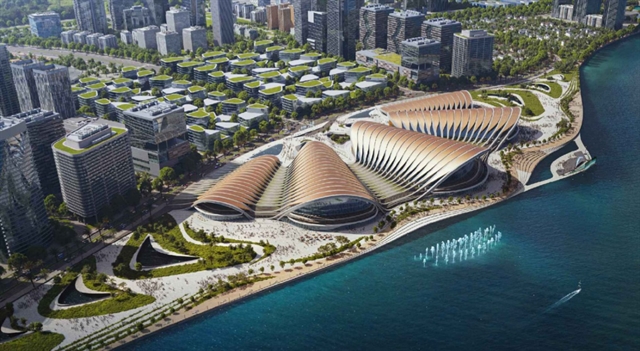 Society
Society

 |
| A render of the waterfront theatre in the central area of the Cần Giờ urban area. — Photo courtesy of Cần Giờ District People's Committee |
HCM CITY — HCM City plans to turn Cần Giờ District into an ecological urban area as part of efforts to urbanise it and improve the quality of life for locals.
With a 13-km coastline and extensive mangrove forest intertwined with a dense system of rivers, canals and diverse flora and fauna, Cần Giờ has huge potential to develop eco-tourism, community-based tourism, and resort tourism, experts say.
A coastal district located 50km from the city centre, Cần Giờ has a total area of more than 70,412ha, including more than 33,000ha of mangrove forests. The Cần Giờ Mangrove Forest was recognised as a biosphere reserve by UNESCO in 2000. Its salt making villages, swallow nest areas, seafood and fruit gardens are all appealing tourist attractions.
The city plans to solicit investment in the district, especially in major projects such as the Cần Giờ Sea Encroachment project, Cần Giờ Bridge, an upgrade of the Rừng Sác route, and a ferry port.
The City also aims to boost sustainable development of services, agriculture and the marine economy, protect the mangrove forests and build the district into an international entertainment and tourism area.
It also plans a number of major urbanisation projects in Cần Giờ.
They include the 3.4km Cần Giờ Bridge on the Soài Rạp River between the district and the rest of the city.
A high-speed boat service will be operated between Bạch Đằng Wharf in the downtown area, the district and neighbouring Vũng Tàu City.
A proposed helicopter charter service between downtown and Cần Giờ will cater to local and international tourists.
A sea bridge between Cần Giờ and Vũng Tàu will also be built by 2025.
The City also plans to build the Cần Giờ Sea Encroachment Project, which is expected to help create 25,000 jobs and bring significant revenue to the city.
It will be developed in the coastal Long Hòa Commune and Cần Thạnh Town on an area of 2,870ha by the Cần Giờ Tourism Urban Area Joint Stock Company.
It will be situated some 18km from the famous Cần Giờ Mangrove Biosphere Reserve, close to the Xoài Rạp and Lòng Tàu rivers, 17km from the Vàm Sát Eco-Tourism Area, and 4km from Monkey Island.
The district is expected to contribute to the city’s economy by creating more jobs and bringing in revenue.
Cần Giờ’s tourism development has been relatively slow since it can only be reached by ferry, but the construction of the huge bridges linking it with the rest of the city will make it easier to reach.
The district has recently seen a 50 per cent average increase in the number of visitors per year.
Cần Giờ District is the only area bordering the sea in HCM City.
It has tourist attractions such as Monkey Island, Hàng Dương Seafood Market, the Vàm Sát Ecological Tourist Area, and Rừng Sác (Sác Forest).
Cần Giờ is also well-known for its annual Nghinh Ông (Whale Worshiping) Festival recognised as a National Intangible Cultural Heritage by the Ministry of Culture, Sports and Tourism.
Studies have shown that the Cần Giờ mangroves help filter grey water from upstream and regulate flood flows.
One of the world’s largest rehabilitated mangrove forests also serves as a green lung and a bulwark shielding the city from storms and extreme weather. — VNS